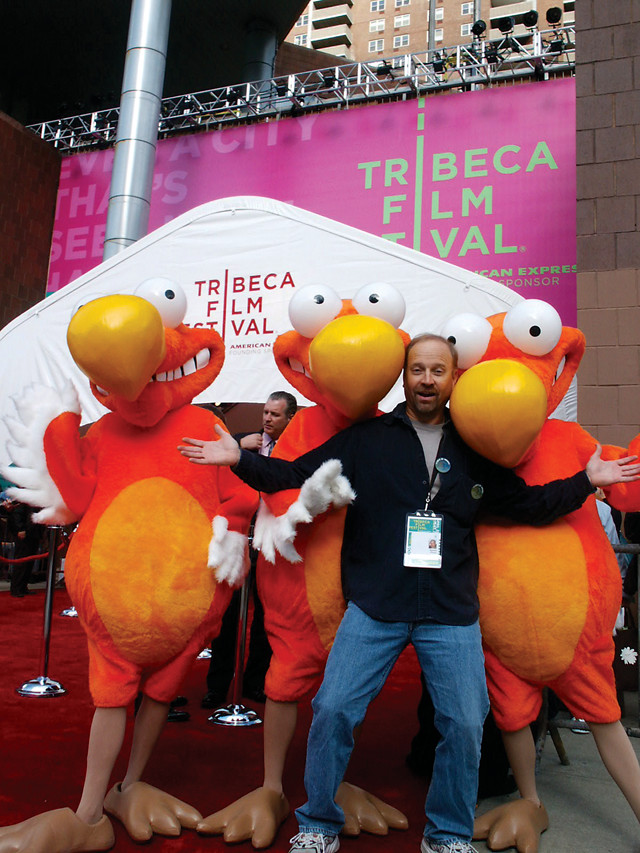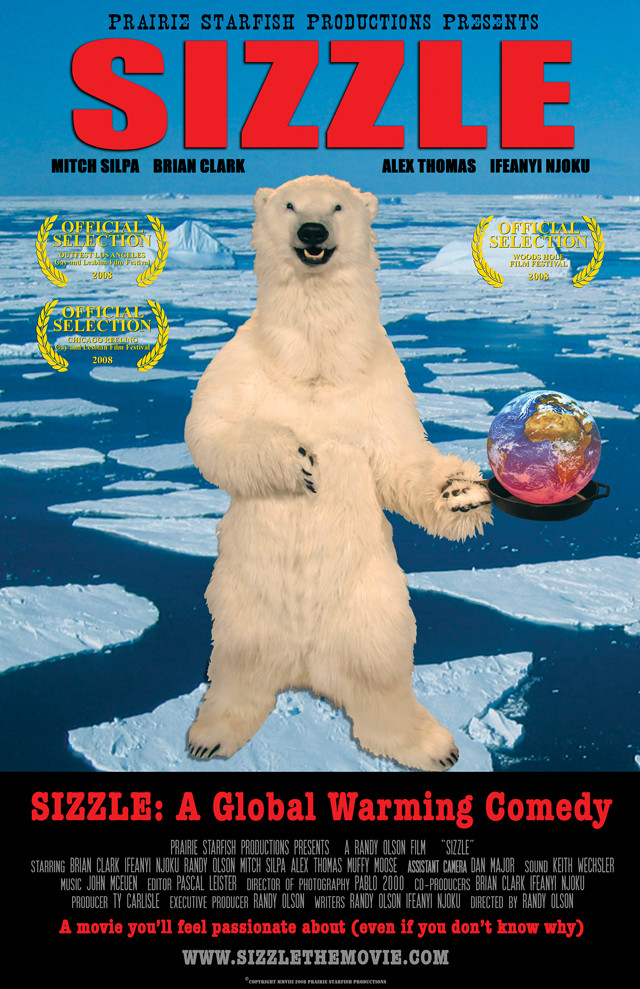
by Erin Wayman Wednesday, May 23, 2018

Randy Olson poses with a flock of dodos at the 2006 Tribeca Film Festival. Credit: Katarzyna Balug
Marine biologist-turned-filmmaker Randy Olson made a name for himself in 2006 with the release of his first feature-length movie, “Flock of the Dodos: The Evolution-Intelligent Design Circus.” He followed that success with last year’s “Sizzle: A Global Warming Comedy.” These movies feature hot-button science issues, but they are not documentaries. Rather, Olson says, they are designed to entertain and spark an interest in the scientific topic — whether evolution or climate change — so that viewers will want to learn more.
Now Olson is sharing what he has learned about the challenges of communicating science in his new book, “Don’t Be Such a Scientist: Talking Substance in an Age of Style,” which comes out in August. Olson recently talked with EARTH’s Erin Wayman about the book, making movies and why scientists are really storytellers.
EW: When you were a researcher, what did you study?
RO: I was a marine biologist. After I finished my Ph.D., I went [to Australia] and did a post-doc. I worked on the crown-of-thorns starfish problem. That’s the starfish that eats up all the live corals on reefs. I worked for three or four years studying the reproduction of the starfish. In 1988, I got a tenure-track professorship at the University of New Hampshire and began making short films shortly after getting there. The rest is history. [Laughs]
EW: What were your first films about?
RO: The very first film that I did was a very silly five-minute film. The title was “Lobstahs.” The theme was how to eat a lobster. We got two local lobster fishermen who told us in their “down east” vernacular how they eat a lobster. I sent it into the New England Film and Video Festival. One of my scientist friends told me the film was utterly horrible and I needed to give up because it showed I had no talent. His words were so devastating that I was ready to cease and desist. But I had already sent it into the festival. And then lo and behold, we won an award. Then the next year I had some other ideas and I started writing a whole bunch of songs about sea creatures. One of them that we recorded was a jazz song about the sex life of barnacles called “Barnacles Tell No Lies.” The recording turned out so good that we ended up turning it into a music video. That music video is on YouTube these days.

Sizzle Poster. Credit: Prairie Starfish Productions
EW: Was there a point when you decided you were done doing science?
RO: You know, I get asked a lot, “How in the world did you go from being a scientist to being a filmmaker?” The unifying theme in the two careers is storytelling. Whether scientists realize it or not, they are storytellers. That is not something that gets taught to scientists.
EW: Does “Don’t Be Such a Scientist” offer suggestions on how scientists can be better storytellers?
RO: Certainly. The starting point begins with understanding the difference between a statement and a question. When you do research, you are trained to develop good research questions. But what doesn’t happen very much is [teaching] how those questions are also crucial parts of communication. A typical scientist has a first instinct to just blurt out all the information in statements. But in fact, the real challenge is whether you take your information and craft it as questions to maintain interest in the person who is listening to you.
EW: Is that the take-home message of the book?
RO: That’s one portion of it. [The book] is about the nuts and bolts of how to make your information-heavy message understandable and digestible to a broader audience. So the message of the book is the title of the first four chapters: “Don’t Be So Cerebral,” “Don’t Be So Literal-Minded,” “Don’t Be Such a Poor Storyteller” and “Don’t Be So Unlikable.”
The fifth chapter is a very positive statement: “Be the Voice of Science.” This chapter begins with a profile of Carl Sagan and tries to show how Carl Sagan was just about the most successful broad communicator of science because he completely followed all four of those admonitions. Carl Sagan was a tremendous storyteller. And he was hugely likable. He was willing to go on Johnny Carson’s couch and make nonsensical banter with all these celebrities in an effort to communicate science. That helped him reach a broader audience, and at the same time, that irked a lot of major scientists who thought it was a waste of his time.

Randy Olson in a scene from "Sizzle." Credit: Prairie Starfish Productions
EW: When did you realize it takes a lot of effort to get the public’s attention?
RO: I think it was a slow realization. The fundamental difference [between academics and the general public] is that the academic audience communicates through substance whereas the broader audience communicates more through style.
EW: Are your movies examples of how to have both substance and style?
RO: Absolutely. One of the things I’ve tried to do with my movies is create a broader, more likable voice. We achieved that with “Flock of Dodos.” It is more of a stimulatory tool than a beat-you-over-the-head information bonanza. The general public is not that motivated that they want to hear mountains of information off the bat. The result is a very simple rule of thumb that a professor at the University of Southern California Annenberg School for Communication told me 10 years ago: To communicate to a broad audience, you only need two things — arouse and fulfill. You need to arouse the interest of your audience. Then once they’re interested, you have to fulfill their expectations.
The novel thing we’ve been doing for the past three years with my two movies is to show the movie and then when it’s over, we bring out the experts. What you end up with is an audience that has found the subject interesting and engaging, but they haven’t been given enough information that they feel like they totally understand the whole thing … What better time to bring out these boring academics, who by themselves the audience would not want to sit and listen to. But when you put the audience in a situation where they are now desperate to get this thing sorted out, suddenly the academics are their heroes.
EW: Do you ever miss being a scientist?
RO: Not at all. As I said, I’m a storyteller. And the reason I went into science was to tell interesting, good stories. The two professions are identical. The differences are all superficial. One of them involves going to fancy parties at the Sundance Film Festival. The other involves going to scientific meetings and talking about formulas. [Laughs] But in the end, they both involve problem solving.
© 2008-2021. All rights reserved. Any copying, redistribution or retransmission of any of the contents of this service without the expressed written permission of the American Geosciences Institute is expressly prohibited. Click here for all copyright requests.